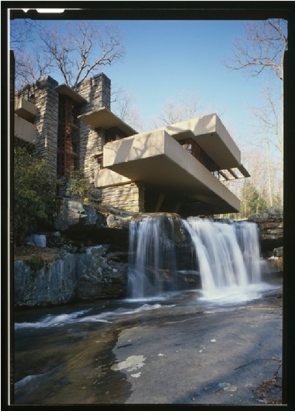Ben Jacks
Miami University, Oxford, Ohio
jacksbm@miamioh.edu
. . . artist and perceiver alike begin with what may be called a total seizure, an inclusive qualitative whole not yet articulated . . . . Moreover, not only does the “mood” come first, but it persists as the substratum after distinctions emerge; in fact they emerge as its distinctions.
—John Dewey[1]
What is style? Every flower has it; every animal has it; every individual worthy the name has it in some degree. . . . the result of an organic working out of a project in character and in one state of feeling. An harmonious entity of whatever sort in its entirety cannot fail of style in the best sense.
—Frank Lloyd Wright[2]
Summary Statement
The theme of this 11th ACSF symposium, inspired by the concept of continuity and its Deweyan origins in the work of Frank Lloyd Wright, provides fertile ground for exploring questions about the nature of spiritual architectural atmosphere. For Wright, continuity facilitated the creation of atmosphere, a term he employed throughout his career, beginning with his earliest writing and speeches. Continuity, synonymous with organic architecture itself, refers to a quality that is achieved only when every aspect of a project—its spatiality, materiality, structure, detail, and mediation of natural elements (light, sound, weather, site, etc.)—work together to produce a single entity, overwhelming in its style, “ . . . the result of an organic working out of a project in character and in one state of feeling.”
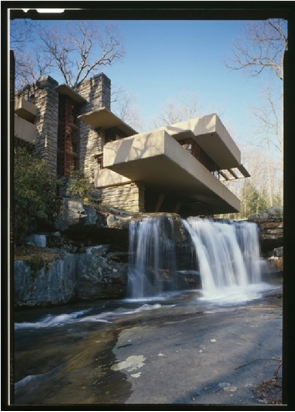
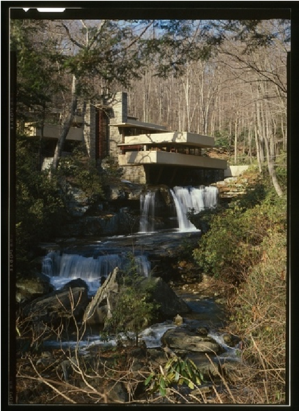

Jack E. Boucher, Historic American Building Survey photographs, 1985, Library of Congress Prints and Photographs Division, Washington, DC.
Topic
This paper considers architectural atmospheres by entertaining some questions, germane and important to the current discourse on atmospheres, that have not yet been addressed together. For example: What distinguishes the atmosphere of a site—the surrounding natural environment—within which a building is situated? How does the atmosphere of a site differ from that of the building interior within it? What is the nature of the transition from one atmosphere to another? What is required to end one atmosphere and begin another? In what sense are architectural atmospheres continuous with one another? How is a spiritual architectural atmosphere bounded? How are spiritual atmospheres continuous with profane ones?
Scope
Although these questions are applicable to works of architecture generally, this paper explores them through the example of Fallingwater, with particular focus on the idea of spiritual atmospheres. As the most famous of all Wright’s projects, about which much has already been written, the aim is not to add to Fallingwater scholarship. Much has been said about Wright’s use of mass and openings, of diagonal lines of sight and lines of movement, the interpenetration of interior and exterior, and the ennoblement of humanity by nature. Wright achieved a unique, and arguably spiritual, architectural atmosphere at Fallingwater. As a major work of art of undisputed quality, it serves to illustrate some key concepts in a new framework. Fallingwater is not a religious structure, and yet it has been proclaimed a spiritual experience by those who have visited. It therefore serves well to suggest how architectural atmospheres become spiritual ones.
In addition, representation frequently arises as a problem in discussions of architectural atmosphere. Architectural photographs may superimpose their own compelling, seductive, or misleading atmospheres, and there is a received iconography in photography. While this problem is a challenge not easily overcome, the Historic American Building Survey photographs of Fallingwater, by Jack Boucher (1985), involve a certain artlessness and clinical distance that help the reader back to an actual encounter with the whole work in its setting. Published here, the HABS photographs offer a fresh opportunity to address the problem of the representation of atmospheres through photographs.
Method
The paper addresses four key concepts or conditions, layering, modification, enclosure, and distinction, that together help define continuity and boundaries in architectural atmospheres.
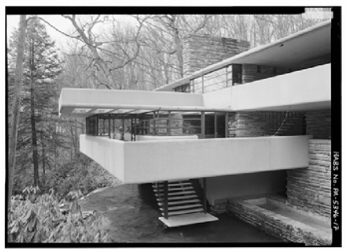
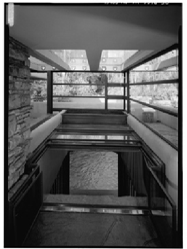
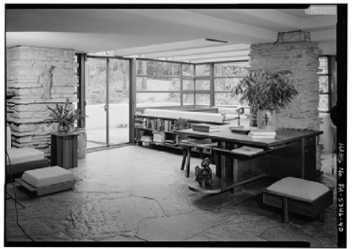
Jack E. Boucher, Historic American Building Survey photographs, 1985, Library of Congress Prints and Photographs Division, Washington, DC.
Layering
The experience of Fallingwater is freighted with factors ancillary to the work itself. This is true of any work of art, perhaps only more so at Fallingwater. Above all are the stories and myths and truths about the man Frank Lloyd Wright, understandings about the origin of the artist’s unique and singular vision, and the house museum or walking tour context that overlays it. Beneath these factors lies the work as architecture, to the extent that it may be separated from social, cultural, and historical context and other factors. To clear away the clouding ancillary factors so as to properly perceive the work per se is to get to something that is valuable to the student, designer, and visitor alike. It is the perceiver’s task to recognize atmospheric distraction and to minimize it in aesthetic engagement and art appreciation.[3]
Philosopher of aesthetics Arnold Berleant extended Deweyan aesthetic theory mainly through two works, The Aesthetic Field (1970),and Art and Engagement (1991), and helps us to make sense of the layering of ancillary factors onto the work and to control our perceptions. Berleant structures the categories creative, objective, performative, and appreciative in the roles of the artist, the art object, the performer, and the perceiver engaged together in the aesthetic field. Like Dewey, Berleant understands aesthetic experience, “the total situation in which the objects, activities, and experiences of art occur,” as contrasting with the more or less undifferentiated flow of everyday experiences.[4] With the aesthetic field thus structured, Berleant intends to see how each distinctive feature appears in different kinds of art. Perhaps Berleant’s greatest contribution is to recognize the role of the performer, which raises some interesting questions for architectural atmospheres. Sometimes the roles of performers and perceivers blur and cross, a situation that helps expose the nature of engagement and reduces aesthetic distancing as a precondition for perception. Mindful of Berleant’s schema, the perceiver can engage the work with greater attentiveness. In the case of Fallingwater, human visitors are performers as well as perceivers. We hear the stories of the Kaufmann’s and the craftsmen as performers and perceivers alike.
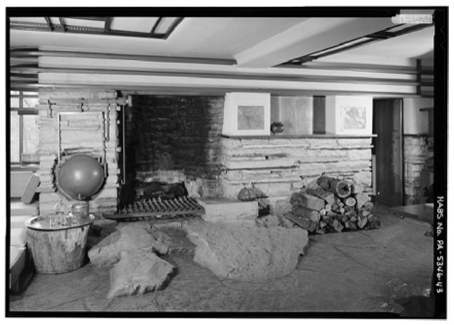
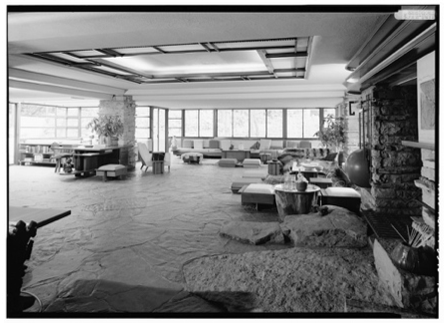
Jack E. Boucher, Historic American Building Survey photographs, 1985, Library of Congress Prints and Photographs Division, Washington, DC.
Modification
Entering into the atmosphere of the work of architecture are the multiple elements that modify it: chief among them light (and shadow), scale, color, materials (and their textures), and human use, but also sound, air movement, temperature, time (registered as age, but also as celestial and bodily movement measuring passage of time), smell (and taste). The work of architecture is rather obviously much more than the lines and angles that define it; there is a reciprocal relationship between the modifying elements and the architecture they modify.
It seems at first to make sense to think of the general ambience of the site as preceding the building and the building merely taking best advantage of the site’s proclivity. But the expression of the modifying elements in the architectural atmosphere goes well beyond merely taking up what is given in the ambience of the context. The way a particular work harnesses the modifying elements at its disposal to create an architectural atmosphere is much more than merely additive; a building does more than simply bring out that which is latent. Writing in the final issue of Daidalos—a dedicated journal issue contributing early to the current discourse on atmospheres— Mark Wigley remarks, focusing especially on Wright, that since a site has its own ambience the building is a device for producing an atmosphere within another one and creating a situation in which one may pass from one atmosphere to another. He continues, “Architecture is to be found in the relationship between atmospheres, the play between microclimates. The meeting of these seemingly ephemeral atmospheres can be as solid as any building.”[5] And while the solid boundary between adjacent atmospheres is most often solid building proper, when it is not it is because of a distinct difference in the modifying elements.
In the case of Fallingwater, Wright intuited how to make the building a machine for capturing and transforming the atmosphere of the site, which he did actually with the famous hatchway covering the stair to the stream. He of course knew, even without consulting a psychrometric chart, how the cool moist air of the stream would serve to cool the air on a hot day (in this his Arizona experience was of course instructive, in addition to his experience on site). He thus combined the means for altering atmosphere with a metaphor of atmosphere, while also creating a distinctive architectural atmosphere. It goes without saying that light and shadow, scale, color, materials, use, sound, air movement, temperature, time, and smell all figure profoundly in Wright’s creation of atmosphere at Fallingwater, and contribute to its power.
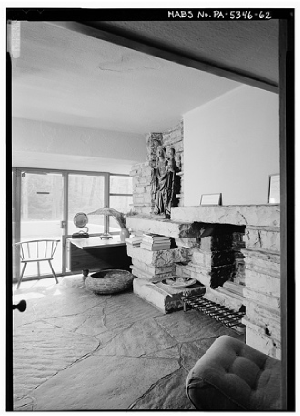


Jack E. Boucher, Historic American Building Survey photographs, 1985, Library of Congress Prints and Photographs Division, Washington, DC.
Enclosure
Enclosure is often the definitive boundary between architectural atmospheres. Exterior and interior present feelings that change abruptly when one crosses a threshold. And yet, in the case of Wright, continuity—organic architecture—demanded no such change or sharp division. Rather, organic architecture extended nature, “with a capital N,” as Wright conceived it. The occasion for enclosure—the building—called for a subtle separation between inside and outside. In Modern architecture in general, and Fallingwater in particular, the goal was not to eliminate the barrier between interior and exterior, but to allow each to interpenetrate the other, particularly as perceived from within the enclosed space. At Fallingwater openings operate in various ways to break the box and to frame activity, view, and “nature” so that interior and exterior become part of a single whole, not only horizontally between the person and the forest, but also at points vertically between the light of the stream and the light of the sky. At Fallingwater atmosphere is rather more literally weather; the atmosphere of the forest and the atmosphere inside the building are one. Nature—spiritual atmosphere—imbues the enclosed architectural atmosphere of the house.
Distinction
An architectural atmosphere is distinct when in comparison it is singularly itself. When, in Dewey’s words, “. . . artist and perceiver alike begin with what may be called a total seizure, an inclusive qualitative whole not yet articulated . . . .” Frank Lloyd Wright described the difference between Taliesen in Spring Green, and Taliesen West, in terms of the qualities of landscape that lead immediately to differences in structure and form—as a consequence of the unity of architecture and landscape—that in turn lead to differences in the atmospheres of the two places. Wright said, “. . . . In Wisconsin erosion has . . . softened everything. Out there everything was sharp, savage. . . . armed in the desert. It was an entirely new experience, and still following our same feeling for structure . . . for building . . . it had to be absolutely according to the desert.”[6] Here continuity confers distinction in architectural atmosphere. By whatever means, distinction is the sine qua non of an architectural masterpiece.
Intended Conclusions/Outcomes
Together the four concepts explored in this paper—layering, modification, enclosure, and distinction—provide a framework for understanding continuity and the boundaries of architectural atmospheres. Architectural atmospheres, sometimes called ambiences, work differently than atmospheres seen more generally, and atmospheres seen from the vantage point of other academic disciplines. Something solid, a set of actual objects—the architectural enclosure, the building—is substantially responsible for the construction of architectural atmosphere, and this rests within the province of the designer’s agency. In the case of Frank Lloyd Wright and Fallingwater, that agency is mastery.
References:
Arnold Berleant, The Aesthetic Field, a Phenomenology of Aesthetic Experience, (Springfield, IL: Charles C Thomas, 1970).
Arnold Berleant, Art and Engagement, (Philadelphia: Temple University Press, 1991).
Gernot Böhme, ed. Jean-Paul Thibaud, The Aesthetics of Atmospheres, (London: Routledge, 2017).
Christian Borch, ed., Architectural Atmospheres: On the Experience and Politics of Architecture
Daidalos: Berlin architectural journal, Konstruktion von Atmosphären, Constructing Atmospheres,68, (Berlin: Bertelsmann, 1998).
John Dewey, Art as Experience, (New York: Capricorn Books, 1934).
Tonino Griffero, tr. Sarah de Sanctis, Atmospheres: Aesthetics of Emotional Spaces, (Surrey: UK, Ashgate, 2014).
Edgar Kaufmann, Jr. Fallingwater: A Frank Lloyd Wright Country House, (New York: Abbeville Press, 1986).
Neil Levine, The Architecture of Frank Lloyd Wright, (Princeton, NJ: Princeton University Press, 1996).
Bruce Brooks Pfeiffer, The Essential Frank Lloyd Wright, (Princeton, NJ: Princeton University Press, 2008).
Robert Twombly, ed., Frank Lloyd Wright: essential texts, (New York: W.W.Norton, 2009). Lynda Waggoner, ed. Fallingwater, (New York: Rizzoli, 2011).
[1] John Dewey, Art as Experience, (New York: Capricorn Books, 1934), 191-192.
[2] Frank Lloyd Wright, “Studies and Executed Buildings, (1910),” in Robert Twombly, ed., Frank Lloyd Wright: essential texts, (New York: W.W.Norton, 2009).
[3] It is perhaps also the educational responsibility of the professional organization charged with curating the work. Edgar Kaufmann, Jr. well understood this issue and sought to instill his vision in the Western Pennsylvania Conservancy with whom he entrusted the educational mission, and which carries it forward today. See Lynda Waggoner, ed. Fallingwater, (New York: Rizzoli, 2011), 11-17.
[4] Arnold Berleant, The Aesthetic Field, a Phenomenology of Aesthetic Experience, (Springfield, IL: Charles C Thomas, 1970), 47.
[5] Mark Wigley, “Die Architektur der Atmosphären/ The Architecture of Atmospheres”. Daidolos 68: 18-27.
[6] Frank Lloyd Wright, film interview by Hugh Downs, A Conversation with Frank Lloyd Wright-from NBC’s Wisdom Series, (New York: National Broadcasting Corporation, 1958).

